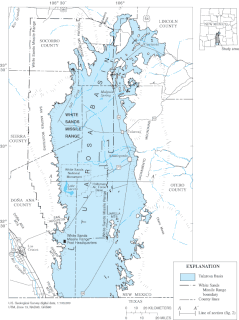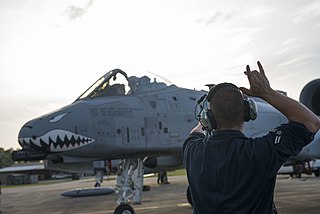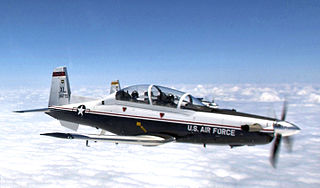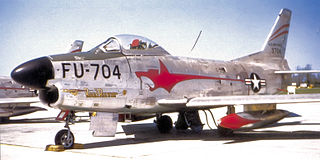| 82d Aerial Targets Squadron | |
|---|---|
 | |
| Active | 1942-1945; 1946-1971; 1981-present |
| Country | |
| Branch | |
| Role | Aerial target operation |
| Garrison/HQ | Tyndall Air Force Base |
| Engagements | |
| Decorations | Distinguished Unit Citation (2x) Air Force Outstanding Unit Award (7x) Air Force Organizational Excellence Award [1] |
| Insignia | |
| 82d Aerial Targets Squadron emblem [1] (modified c. 1995) |  |
| 82d Fighter-Interceptor Squadron emblem (approed 15 March 1951) [2] | 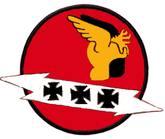 |
The 82d Aerial Targets Squadron is a United States Air Force unit. It is assigned to the 53d Weapons Evaluation Group and stationed at Tyndall Air Force Base, Florida.

The United States Air Force (USAF) is the aerial and space warfare service branch of the United States Armed Forces. It is one of the five branches of the United States Armed Forces, and one of the seven American uniformed services. Initially formed as a part of the United States Army on 1 August 1907, the USAF was established as a separate branch of the U.S. Armed Forces on 18 September 1947 with the passing of the National Security Act of 1947. It is the youngest branch of the U.S. Armed Forces, and the fourth in order of precedence. The USAF is the largest and most technologically advanced air force in the world. The Air Force articulates its core missions as air and space superiority, global integrated intelligence, surveillance, and reconnaissance, rapid global mobility, global strike, and command and control.

The 53d Weapons Evaluation Group is a United States Air Force unit that reports to the 53d Wing. It is stationed at Tyndall Air Force Base, Florida. The unit is part of Air Combat Command.

Tyndall Air Force Base is a United States Air Force Base located 12 miles (19 km) east of Panama City, Florida. The base was named in honor of World War I pilot 1st Lt. Frank Benjamin Tyndall. The base operating unit and host wing is the 325th Fighter Wing of the Air Combat Command (ACC). The base is delineated as a census-designated place and had a resident population of 2,994 at the 2010 census.
Contents
- Overview
- History
- World War II
- Air Defense Command/Aerospace Defense Command fighter interceptor unit
- Air Training Command
- Aerial Target Unit
- Watercraft
- Lineage
- Assignments
- Stations
- Aircraft
- References
- Bibliography
- External links
The squadron was first activated as the 82d Pursuit Squadron in 1942. Flying Lockheed P-38 Lightnings, the squadron saw combat as the 82d Fighter Squadron during World War II in the European Theater of Operations, earning a pair of Distinguished Unit Citations for its actions in combat.

A squadron in air force, army aviation, or naval aviation is a unit comprising a number of military aircraft and their aircrews, usually of the same type, typically with 12 to 24 aircraft, sometimes divided into three or four flights, depending on aircraft type and air force. Land based squadrons equipped with heavier type aircraft such as long-range bombers, or cargo aircraft, or air refueling tankers have around 12 aircraft as a typical authorization, while most land-based fighter equipped units have an authorized number of 18 to 24 aircraft.

The Lockheed P-38 Lightning is a World War II–era American piston-engined fighter aircraft. Developed for the United States Army Air Corps, the P-38 had distinctive twin booms and a central nacelle containing the cockpit and armament. Allied propaganda claimed it had been nicknamed the fork-tailed devil by the Luftwaffe and "two planes, one pilot" by the Japanese. The P-38 was used for interception, dive bombing, level bombing, ground attack, night fighting, photo reconnaissance, radar and visual pathfinding for bombers and evacuation missions, and extensively as a long-range escort fighter when equipped with drop tanks under its wings.

World War II, also known as the Second World War, was a global war that lasted from 1939 to 1945. The vast majority of the world's countries—including all the great powers—eventually formed two opposing military alliances: the Allies and the Axis. A state of total war emerged, directly involving more than 100 million people from over 30 countries. The major participants threw their entire economic, industrial, and scientific capabilities behind the war effort, blurring the distinction between civilian and military resources. World War II was the deadliest conflict in human history, marked by 50 to 85 million fatalities, most of whom were civilians in the Soviet Union and China. It included massacres, the genocide of the Holocaust, strategic bombing, premeditated death from starvation and disease, and the only use of nuclear weapons in war.
Inactivated after the war, the squadron was activated for the air defense, first in the United States, then on Okinawa. It was inactivated in 1972, but activated again the following year as the 82d Flying Training Squadron and trained pilots for the Air Force for the next four years. It was activated in its most recent role in 1981.

